FEATURES|THEMES|Commentary
The Dana Dilemma: Is It Buddhist to Pay for Teachings?
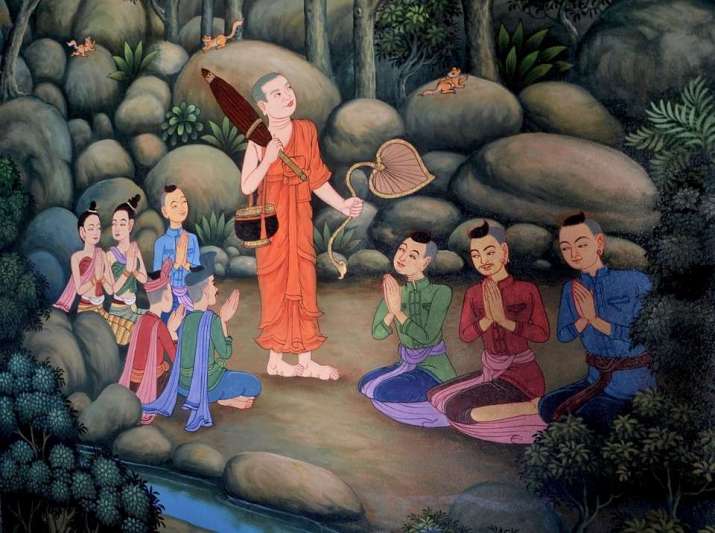
When I say the word dana, what comes to mind? “Dollar signs,” says my friend, a long-time meditator and retreatant. “And then the translation of that Pali word, dana: generosity.” Ajahn Sucitto, a senior monk in the Thai Forest tradition, says this about dana: “Everything is dana. We’ve been given birth. We’ve been given bodies. We are in a universe of dana and we participate in that. Dana is not a donation. Unfortunately, it gets commercialized or trivialized into that.”
Generosity is at the foundation of all Buddhist teachings. But these two ideas about what dana can be—a monetary transaction versus a field of virtue—reveal a breach in understandings and practices at work in the ways that Buddhism has unfolded in the West. This muddled situation is hard to avoid as retreats and other forums commodify Buddhist ideas. The emergence of corporate mindfulness is a prime example. At the same time, the West is also a second home to monastic lineages that still adhere to the strictest rules the Buddha laid down proscribing the handling of money. When the teachings become entangled with a capitalist transactional model, what’s at risk? Are we understanding the full breadth and depth of dana in the way that the Buddha intended?
Buddhism is still fairly new in North America. Over millennia, its weave into Asian cultures also contended with the gap between the purity of the Buddha’s teachings and the activities of the societies that have adopted them. In the West, we now find an awkward hybrid sprouting, one that is producing a plethora of opportunities—from meditation classes in corporate boardrooms and on Capitol Hill to the inclusion of more women in teaching leadership.
Institutions and teachers are responding to the challenge in myriad ways, approaching this long-standing issue in Buddhism along a spectrum, from more secular vantage points to faith-based ones. Each strategy has its pros and cons, but for the most part, all are tasked with trying to keep the Buddha’s idea of dana and radical generosity alive in a consumerist culture. Although these issues will be examined here through the lens of the Theravada tradition in North America, the tradition I’m most familiar with, hopefully they can serve as a case study with implications for other schools.
In the beginning: without price
The Dhamma—the teaching of the Buddha—has been considered priceless by his disciples across the millennia. It was taught freely by monks, nuns, and sometimes laypeople. The Buddha didn’t require monastics to teach, but to this day, if they choose to do so, teaching must be offered as a gift; monks and nuns cannot ask for anything in return. When they ordain, they are entitled to cast-off cloth, a root of a tree to sit upon, scraps of food, and the most basic medicine. The Buddha didn’t forbid his monastics from accepting material gifts if those gifts were given freely and didn’t consist of money, gold, or silver. But monks and nuns could not ask for or use money. In fact, to this day, monastics in more orthodox branches of Buddhism, especially Theravada, cannot ask for anything at all (unless someone has previously said, “If you need this or that, let me know”), or even hint for anything but water unless they are ill.
Not all traditions hold to the rules so strictly, but monastic frugality was designed as it was for a reason: it helps them offer the teachings without strings attached. Because monks and nuns can never expect more than the basic necessities, the Buddha understood that there is less incentive to alter the teachings for material gain.
The underpinning of this paradigm was, and is, the long-standing tradition of a local laity providing for the basic requisites of monks and nuns. This arrangement is not dissimilar to other religious institutions that provide for clergy. But in many ways it goes further: in the most conservative Buddhist denominations, monastics eat nothing at all after noon. They are forbidden to store food overnight because the Buddha intended that they be dependent and vulnerable on a daily basis. A seemingly impractical and risky model, especially from a contemporary perspective, dana is a living relationship of radical trust in people’s goodness. Over millennia, this trust has not been misplaced: the Buddhist monastic sangha is one of humanity’s oldest continuous institutions.
“The reason we emphasize giving and generosity is because of the frequency with which the Buddha spoke about it,” says Ven. Dhammadipa, a nun in residence at Aloka Vihara, a Theravada women’s hermitage in Placerville, California. “He spoke about giving in lots of different ways, among them: living an ethical life so that others can trust you; the gift of presence and spiritual friendship;” and, most notably for this discussion, “the gift of material things because greed is one of the most pervasive problems humans face.”
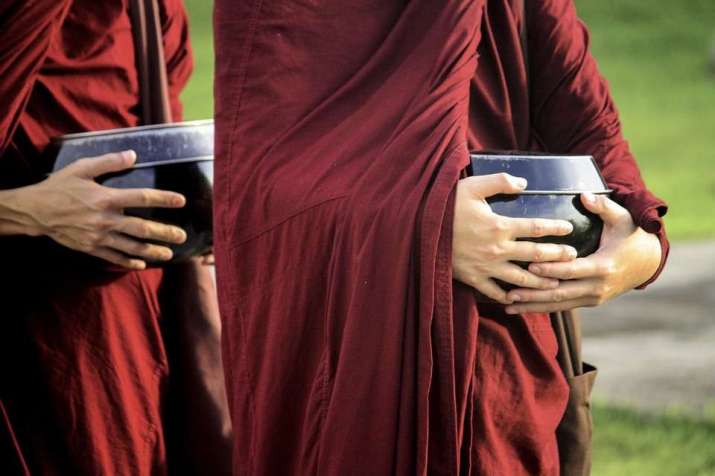
There’s an inherent conflict in wanting to honor the tradition of freely given teachings with modern structures and institutions. The dissonance, in large part, stems from the issues of livelihood for career lay teachers, the high cost of retreats, and the capitalization and maintenance of retreat and Dhamma centers. Adhering to the Buddha’s tenets of generosity within this swirl of financial complications is an experiment that’s never been tried in Buddhism’s long history until now.
“Dana can be a bit of a sore point all around,” says Ajahn Sudanto, abbot of Pacific Hermitage in White Salmon, Washington. “I’ve heard monastics, lay teachers, and administrators of centers talk about how they try to balance the work that they do—offering teachings and programs—and pay for it all. I find it kind of sad that we haven’t figured this out. It’s gone on for decades and there’s still a lot of hand-wringing.”
It’s easy to conflate the monastic model with purity and assume that anything else might be tainted or corrupted. Aspects that rub particular to a historically Judeo-Christian culture further muddies the issues of dana: is money good or bad? The source of all evil, or the source of freedom? Because we have few ways to validate the value of something in our culture other than quantifying it in monetary terms, many feel caught in an ethical paralysis.
Flashpoints
A major flashpoint in the growth of Buddhism, particularly in the West, is the rise of lay teachers as professionals—people who earn their living and support their families by teaching the Dhamma. In fact, the number of laity teaching in the West far surpasses the number of monastics. The Buddha spoke of teaching the Dhamma as one of the greatest acts of compassion for others, yet the proliferation of lay teachers is new territory: “I don’t know that it’s ever been really tried, to transmit the Dhamma in this way—as a ‘profession,’” says Ajahn Sudanto.
The Buddha didn’t dismiss wealth as inherently bad; money itself is not the problem if it is attained by honest means and is used for the benefit of the wider society. In the Ādiya Sutta, “Benefits to be Obtained from Wealth” (AN 5.41), he praises five aims for a wise householder’s righteously obtained wealth.
In many other suttas, however, and in much of the Vinaya or Buddhist monastic code, the Buddha sets a very high bar for the ethical integrity required for teaching. “One should not teach with the wish to inspire listeners so that they make offerings to oneself,” he says in a discourse known as “Like the Moon” (SN 16.3). Even if the Buddha intended the warning for monastics, it could apply to anyone teaching the Dhamma. That many Americans have lost trust in religious institutions and feel more comfortable giving to an individual lay teacher can also be problematic: in a culture driven by individualism and celebrity, do financial pressures push lay teachers to say what their followers might want to hear?
(The issue is further complicated by an emerging awareness among lay teachers that female teachers receive roughly half the dana that male teachers do. The implications of this inequity must be addressed as Dhamma teaching shifts from the purview of monastic institutions, where women have occupied much lower status than men for centuries, to the laity.)
The “dana talk”—the “ask”—for a teacher has become the norm. The talk is most often given by a lay practitioner, not the teacher, to keep a separation from direct requests for support; however, when it comes at the end of a retreat, students are vulnerable and it can easily change the tenor of the retreat experience. Teachers have told me that often when they return to a room full of retreatants after a dana talk, those radiant faces have fallen.
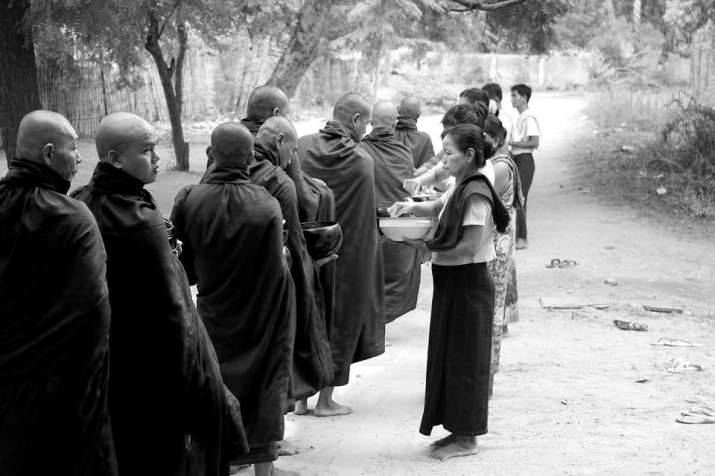
In his essay, “No Strings Attached: The Buddha’s Culture of Generosity,” published on Access to Insight more than a decade ago, Thanissaro Bhikkhu advocated retiring the dana talk. In it, he describes his disappointment in coming back to the US from Asia to find the dana talk tagged onto the end of teachings and retreats. “I understand the reasoning behind the talk,” he writes. “Lay teachers here aspire to the ideal of teaching for free, but they still need to eat. . . . So the dana talk was devised as a means for establishing a culture of dana in a Western context.” He wonders, however, if it seriously distorts Buddhist principles of generosity into the Western context.
Ven. Thubten Chodron, the abbess of Sravasti Abbey, in Newport, Washington, understands that lay teachers are in a difficult position. “If I look at it from their point of view: ‘I’ve given up my career and my profession because I want to dedicate my life to the Dharma, but I still have all the expenses of a householder—spouse, kids, mortgage, car insurance, life insurance, health insurance.’ Lay teachers are really in a bind.” In many ways, she says, monastics are freer to teach than lay teachers—they can accept requests to teach without thinking about how much dana they will receive, and their needs are minimal.
Pricey and priceless
The high cost of Dhamma centers and residential retreats is another flashpoint, one that amplifies class inequity in a society rife with social injustice. To open a retreat catalogue from any of the more renowned lay Dhamma centers can induce sticker-shock: a Theravada center in California offered a month-long residential retreat this past year with a sliding scale range from US$2,800 to US$6,200, plus a donation to the teachers and retreat staff; on the East Coast another major Theravada center offered a five-day residential course ranging from US$600 to more than US$1,000, again not including compensation for the teachers.
My experience is primarily with the Theravada world, but a cursory survey of retreat centers of any Buddhist tradition reveals that, in general, Buddhist lay organizations are diligently trying to bridge the financial gap with scholarships and sliding scales. Almost all Dhamma centers offer some residential program where room and board are traded for work. But the fact remains that purchasing a building is an expensive enterprise, and even renting a retreat facility can be risky for a group to ensure they aren’t left with significant debt. One well-known Theravada teacher I spoke with polled his colleagues and determined that when students don’t pay a deposit, they average a 50 per cent drop rate.
Mirabai Bush, one of the pioneers who brought modern Buddhism from Asia into mainstream America, says that the retreat model is a modern invention, emanating from 20th century Burma, the result of Dhamma teachings migrating away from monasteries. But what got imported into America is ‘that’s Buddhism.’” If retreats that entail catering, accommodations, and swaths of time off from work are at the heart of a religion’s praxis, it will indeed be out of reach for many.
Many Western practitioners aren’t aware that Buddhist monasteries the world over allow visitors to stay without charge, or nearly, and that to keep the monastic schedule of practice, work, and eating secludes a practitioner from their normal life much like a retreat.
There are options in the non-monastic Buddhist world for free teachings and retreats as well. The longest-standing and largest group offering free retreats is the Goenka Vipassana organization, a Burmese association named for the teacher S. N. Goenka (1924–2013) that began in the late 1960s and has inspired many Western Buddhist pioneers to offer retreats in the US.
Today, there are more than 200 Goenka Vipassana centers around the world. Although retreat attendees receive several solicitations asking to support the organization, it's not a requirement: expenses are kept minimal, volunteers make up nearly all the staff and, as with the monastic model, teachers gift their time, receiving no payment. Thousands of Theravada practitioners credit a Goenka course for introducing them to Buddhist meditation in some depth.
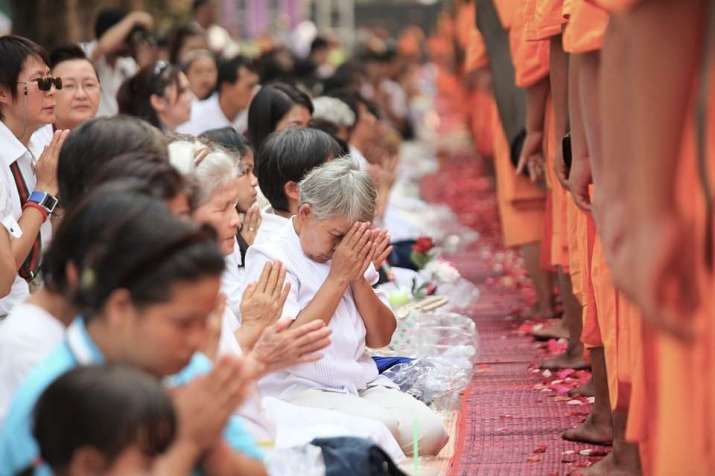
The field of experimentation
There are basically three economic models that the Theravada Buddhist world has engaged in the West: the all dana, everything freely given model; the fee model—just a straight up fee for teachings as well as retreat accommodations; and a hybrid where a fee is charged for direct costs, but there’s a dana request for the teachers and often for the cooks and staff.
Many students I’ve spoken with have complained that the hybrid model should be renamed and not called dana: the way it’s presented they often feel loaded with personal guilt. Will it be their fault if the cook can’t afford health insurance or the teacher has to skimp on groceries? On the flip side, when people are asked to pay a set price, a consumer mentality can enter along with feelings of entitlement. The product needs to meet the expectation.
Gil Fronsdal, the co-teacher of Insight Meditation Center in Redwood City, California, is one of the few lay teachers in the US who leads a Dhamma center as well as residential retreat facility that exist completely from unsolicited dana. As a college student, Fronsdal studied Zen in the United States, and eventually ordained as a monastic in both the Zen and Theravada traditions in Asia. “We were taken care of at the monasteries—money just wasn’t any part of it. That you wouldn't teach to make money was the value I grew up in practicing Buddhism.”
Fronsdal is clear that he doesn’t view IMC’s all-dana arrangement in opposition to other models. “There’s a wisdom in charging,” he says. “A fee allows people to be financially supported in a dignified way if it’s done well. There’s wisdom in paying. It’s a higher bar for deciding whether to commit to sitting a retreat.”
Insight Meditation Center does not charge for anything—weekly teachings or retreats. “This is a very delicate thing we're doing here. We protect this dana system by having a financial buffer,” he says. Fronsdal’s strategy has been intentional, but he’s aware of his luck: he lives in one of the wealthiest areas of the country and, after leaving his monastic robes behind, was more or less drafted to teach by the surrounding community during his graduate studies in Buddhism at Stanford. Fronsdal says that when he has been paid to teach, it changes his relationship to teaching. “I tend to feel a little less motivated by generosity, compassion, and freedom; instead, I feel a bit more that I’m operating under expectations, performance issues, and requirements that come from the financial exchange.”
Mark Nunberg of Common Ground Meditation in Minneapolis, Minnesota, is another teacher whose community has managed to build a Dhamma center and a residential retreat facility based solely on dana. “The whole point is for individuals and communities to explore in a creative way to walk our talk. As people who are interested in Buddhist teachings, what does that look like in terms of teaching and running organizations and all the very practical things that we do as human beings in ways that support awakening, support more freedom and more compassion in the world?”
Like IMC, Common Ground leadership say they are careful not to overreach financially. The group offers everything at no cost as an organizational practice. Nunberg believes that a transactional frame of mind elicits a superficial sense of control. “Instead of saying, ‘Oh, we need this much money in order to fulfill our mission,’ it's more of this place of humility. Like we don’t know what our mission is because part of our mission really depends on this cycle, the circle of giving and receiving.”
An economy of dana
“We don’t have a model of an economy of generosity in this country,” says Ven. Thubten Chodron. “I think of an economy of generosity as people contributing to each other’s welfare and to the welfare of the whole society. What we’re talking about is increasing our joy in giving and being free from transaction.” In a consumerist society, something big may have to shift within individuals for this to occur. And perhaps this points to what we in the Western Buddhist world are grappling with: two dissonant economies. Some long to keep their eye of faith focused on a historically sacred and non commodifiable quality, while others, planted in secular versions of the teachings, tread the whirlpools of the transaction with less worry. But buyer beware: a transaction can begin and end without an echo in the heart.
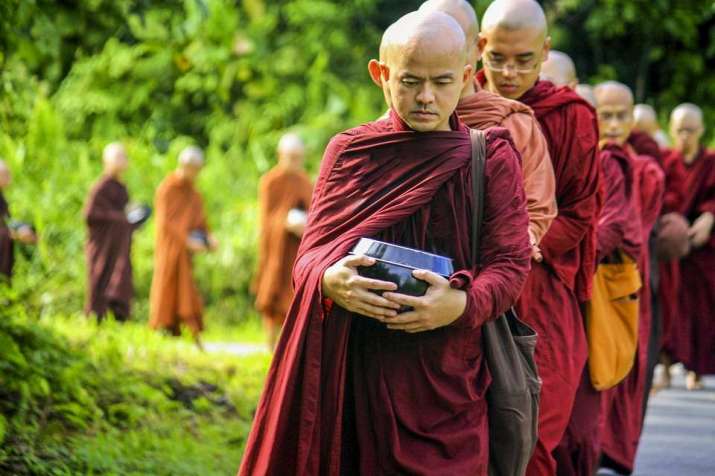
The Buddha’s teachings tell us that generosity offers something profoundly valuable to the human experience—the conviction that inspires serious practitioners to follow the whole of the Noble Eightfold Path, and to labor in the service of spirit over commerce. In Thailand, I’ve seen how a street corner can suddenly transform into a sacred space when the poorest vendor sees an opportunity to give. She will quickly lay out a bamboo mat to kneel on, offer food to a monk, and then receive the same chanted blessing that the King of Thailand receives.
The Buddha didn’t just talk about death and suffering: he spoke about many kinds of joy, especially the joy experienced before, during, and after an act of generosity. “Happiness is a spaciousness inherent in giving,” writes Thanissaro Bhikkhu in his essay, “The Economy of Gifts.” Gladdening the mind is just as necessary and urgent as the more sober disciplines of practice. Dana is the very first paramita, a boundless spiritual perfection in all Buddhist traditions. It isn’t a sideline practice, but a crucial and direct enactment of the Eightfold Path. “Generosity can become a much greater practice,” says Ven. Dhammadipa. “It has the personal joy; it has the sublime abodes of shared enjoyment, mudita (rejoicing); and it has a deeply penetrating teaching about impermanence built within it.”
The Buddha enjoined us to give “wherever the mind feels inspired.” Whether it’s monetary support, our time and labor, the gift of sila or ethical conduct (which makes us reliable and trustworthy), or the gift of silence, we can give what inspires. Generosity in its fullest sense reveals essential truths that transaction can obscure. Perhaps to seek opportunities to give is to seek happiness, knowing that a singular joy is a diminishment compared to a shared joy. Anatta, not self, is only empty of the individual, not of relationship.
My hope when someone hears the word dana in the future, is that dollar signs aren’t the first thing to appear in the mind’s eye, but something much brighter: that the very basis of life is a gift. “Cut off the transaction mind that is always narrowing things down to me and mine. This is the beauty of dana,” says Ajahn Sucitto.
We can remember, finally, that the Buddha, on his deathbed, stated that the highest homage to the teaching is not material dana, but the homage of diligence, of practicing the Dhamma in accordance with the Dhamma (Mahaparinibbana Sutta, DN 16).
Sarah Conover
The Fourth Messenger
Ajahn Sucitto
Venerable Dhammadipa’s Dharma Talks
Bhikshuni Thubten Chodron
Gil Fronsdal (AudioDharma)
Mark Nunberg: Dharma Talks (Common Ground Meditation Center)
Ajahn Sudanto (Pacific Hermitage)
No Strings Attached: The Buddha's Culture of Generosity (Access to Insight)
The Economy of Gifts (Access to Insight)
Vipassana Meditation
Related features from Buddhistdoor Global
The Gift of Giving: Dana in the Pali Canon
The Gift of Giving: #SayadanaEveryday
The View from the Top
Inner Goodness: The Perfection of Morality
The Perfection of Giving














